The Impacts of Random Distributed Vacancy Defects in Steady-State Thermal Conduction of Graphene
Abstract
1. Introduction
2. Materials and Methods
2.1. Steady-State Thermal Conduction
2.2. Thermal Conductivity
2.3. Finite Element Model for Graphene
3. Results and Discussion
3.1. Center Concentrated Vacancy Defects
3.2. Periodic Vacancy Defects
3.3. Random Distributed Vacancy Defects
4. Conclusions
- The center concentrated vacancy defects evidently destroyed the regularity and band characteristic of the temperature field in the steady-state thermal conduction. Moreover, the impacts of periodic and random distributed vacancy defects in temperature field of graphene is not convenient to track.
- The graphene with periodic vacancy defects is sensitive to boundary conditions. The graphene with its heat source in armchair edges has a strengthening effect in the equivalent coefficient of thermal conductivity when periodic vacancy defects is distributed in the first mode. However, graphene with its heat source in zigzag edges is more robust to defend the reduction of the equivalent coefficient of thermal conductivity in the development of periodic vacancy defects. On the contrary, center concentrated and randomly distributed vacancy defects have a consistent equivalent coefficient of thermal conductivity under two boundary conditions.
- Furthermore, the amount and randomness of the vacancy defects are more important than the chirality in stochastically vacancy defected graphene. When Per equals to 0.2%, the reduction of thermal energy fluctuates from 0.3–1%, and from 13–17% when Per is 5%. The thermal energy has discrete range for certain quantity of random vacancy defects. The range of thermal energy is useful when reflecting on the amount of vacancy defects designed as a control switch in devices or instruments.
- The robustness of graphene to resist the fluctuation owing to the randomness of vacancy defects declines sharply when Per is less than 1%. The variance caused by random dispersion of vacancy defects is amplified, according to the increment of Per.
- Different than the center concentrated and periodic vacancy defects, the minimum, maximum, and mean values of thermal energy in graphene with random vacancy defects have a linear decreased tendency with the increase of vacancy amounts.
5. Data Availability Statement
Author Contributions
Funding
Conflicts of Interest
References
- Kim, P.; Shi, L.; Majumdar, A.; Mc Euen, P.L.C. Thermal Transport Measurements of Individual Multiwalled Nanotubes. Phys. Rev. Lett. 2001, 87, 215502–215504. [Google Scholar] [CrossRef] [PubMed]
- Pop, E.; Mann, D.; Wang, Q.; Goodson, K.; Dai, H. Thermal conductance of an individual single-wall carbon nanotube above room temperature. Nano Lett. 2006, 6, 96–100. [Google Scholar] [CrossRef] [PubMed]
- Novoselov, K.S.; Geim, A.K.; Morozov, S.V.; Jiang, D.; Zhang, Y.; Dubonos, S.V.; Grigorieva, I.V.; Firsov, A.A. Electric field effect in atomically thin carbon films. Science 2004, 306, 666–669. [Google Scholar] [CrossRef] [PubMed]
- Geim, A.K.; Novoselov, K.S. The rise of graphene. Nanosci. Technol. 2009, 6, 11–19. [Google Scholar] [CrossRef]
- Novoselov, K.S.; Geim, A.K.; Morozov, S.V.; Jiang, D.; Katsnelson, M.I.; Grigorieva, I.V.; Dubonos, S.V.; Firsov, A.A. Two-dimensional gas of massless Dirac fermions in graphene. Nature 2005, 438, 197–200. [Google Scholar] [CrossRef] [PubMed]
- Zhang, Y.B.; Tan, Y.W.; Stormer, H.L.; Kim, P. Experimental observation of the quantum Hall effect and Berry’s phase in graphene. Nature 2005, 438, 201–204. [Google Scholar] [CrossRef]
- Balandin, A.A. Better computing through CPU cooling. IEEE Spectrum. 2009, 29, 33. [Google Scholar]
- Balandin, A.A.; Ghosh, S.; Bao, W.; Calizo, I.; Teweldebrhan, D.; Miao, F.; Lau, C.N. Superior thermal conductivity of single layer graphene. Nano Lett. 2008, 8, 902–907. [Google Scholar] [CrossRef]
- Ghosh, S.; Nika, D.L.; Pokatilov, E.P.; Balandin, A.A. Heat conduction in graphene: Experimental study and theoretical interpretation. New J. Phys. 2009, 11, 1–18. [Google Scholar] [CrossRef]
- Ghosh, S.; Bao, W.; Nika, D.L.; Subrina, S.; Pokatilov, E.P.; Lau, C.N.; Balandin, A.A. Dimensional crossover of thermal transport in few-layer graphene. Nat. Mater. 2010, 9, 555–558. [Google Scholar] [CrossRef]
- Ghosh, S.; Calizo, I.; Teweldebrhan, D.; Pokatilov, E.P.; Nika, D.L.; Balandin, A.A.; Bao, W.; Miao, F.; Lau, C.N. Extremely high thermal conductivity in graphene: Prospects for thermal management application in nanoelectronic circuits. Appl. Phys. Lett. 2008, 92, 151911. [Google Scholar] [CrossRef]
- Cai, W.; Moore, A.L.; Zhu, Y.; Li, X.; Chen, S.; Shi, L.; Ruoff, R.S. Thermal transport in suspended and supported monolayer graphene grown by chemical vapor deposition. Nano Lett. 2010, 10, 1645–1651. [Google Scholar] [CrossRef] [PubMed]
- Faugeras, C.; Faugeras, B.; Orlita, M.; Potemski, M.; Nair, R.R.; Geim, A.K. Thermal Conductivity of graphene in Corbino membrane geometry. ACS Nano 2010, 4, 1889–1892. [Google Scholar] [CrossRef] [PubMed]
- Jauregui, L.A.; Yue, Y.; Sidorov, A.N.; Hu, J.; Yu, Q.; Lopez, G.; Jalilian, R.; Benjamin, D.K.; Delk, D.A.; Wu, W.; et al. Thermal transport in graphene nanostructures: Experiments and simulations. ECS Trans. 2010, 28, 73–83. [Google Scholar]
- Saito, K.; Dhar, A. Heat conduction in a three dimensional anharmonic crystal. Phys. Rev. Lett. 2010, 104, 040601. [Google Scholar] [CrossRef] [PubMed]
- Lippi, A.; Livi, R. Heat conduction in two-dimensional nonlinear lattices. J. Stat. Phys. 2010, 100, 1147–1172. [Google Scholar] [CrossRef]
- Yang, L. Finite heat conductance in a 2d disorder lattice. Phys. Rev. Lett. 2002, 88, 094301. [Google Scholar] [CrossRef]
- Dhar, A. Heat conduction in the disordered harmonic chain revisited. Phys. Rev. Lett. 2001, 86, 5882–5885. [Google Scholar] [CrossRef]
- Klemens, P.G. Theory of the A-plane thermal conductivity of graphite. J. Wide Bandgap Mater. 2000, 7, 332–339. [Google Scholar] [CrossRef]
- Klemens, P.G.; Pedraza, D.F. Thermal conductivity of graphite in basal plane. Carbon 1994, 32, 735–741. [Google Scholar] [CrossRef]
- Nika, D.L.; Pokatilov, E.P.; Askerov, A.S.; Balandin, A.A. Phonon thermal conduction in graphene: Role of Umklapp and edge roughness scattering. Phys. Rev. B 2009, 79, 155413. [Google Scholar] [CrossRef]
- Berber, S.; Kwon, Y.-K.; Tomanek, D. Unusually high thermal conductivity if carbon nanotubes. Phys. Rev. Lett. 2000, 84, 4613–4616. [Google Scholar] [CrossRef] [PubMed]
- Lindsay, L.; Broido, D.A.; Mingo, N. Flexural phonons and thermal transport in graphene. Phys. Rev. B 2010, 82, 115427. [Google Scholar] [CrossRef]
- Munoz, E.; Lu, J.; Yakobson, B.I. Ballistic thermal conductance of Graphene ribbons. Nano Lett. 2010, 10, 1652–1656. [Google Scholar] [CrossRef] [PubMed]
- Savin, A.V.; Kivshar, Y.S.; Hu, B. Suppression of thermal conductivity in graphene nanoribbons with rough edges. Phys. Rev. B 2010, 82, 195422. [Google Scholar] [CrossRef]
- Huang, Z.; Fisher, T.S.; Murthy, J.Y. Simulation of phonon transmission through graphene and graphene nanoribbons with a green’s function method. J. Appl. Phys. 2010, 108, 094319. [Google Scholar] [CrossRef]
- Hu, J.; Ruan, X.; Chen, Y.P. Thermal conductivity and thermal rectification in graphene nanoribbons: A molecular dynamic study. Nano Lett. 2009, 9, 2730–2735. [Google Scholar] [CrossRef]
- Guo, Z.; Zhang, D.; Gong, X.-G. Thermal Conductivity of graphene nanoribbons. Appl. Phys. Lett. 2009, 95, 163103. [Google Scholar] [CrossRef]
- Evans, W.J.; Hu, L.; Keblinsky, P. Thermal conductivity of graphene ribbons from equilibrium molecular dynamics: Effect of ribbon width, edge roughness, and hydrogen termination. Appl. Phys. Lett. 2010, 96, 203112. [Google Scholar] [CrossRef]
- Aksamija, Z.; Knezevic, I. Lattice thermal conductivity of graphene nanoribbons: Anisotropy and edge roughness scattering. Appl. Phys. Lett. 2011, 98, 141919. [Google Scholar] [CrossRef]
- Lindsay, L.; Broido, D.A.; Mingo, N. Diameter dependence of carbon nanotube thermal conductivity and extension to the graphene limit. Phys. Rev. B 2010, 82, 161402. [Google Scholar] [CrossRef]
- Woodcraft, A.L.; Barucci, M.; Hastings, P.R.; Lolli, L.; Martelli, V.; Risegari, L.; Ventura, G. Thermal conductivity measurements of pitch-bonded at millikelvin temperatures: Finding a replacement for AGOT graphite. Cryogenics 2009, 49, 159–164. [Google Scholar] [CrossRef]
- Jang, W.; Chen, Z.; Bao, W.; Lau, C.N.; Dames, C. Thickness-dependent thermal conductivity of encased graphene and ultrathin graphite. Nano Lett. 2010, 10, 3909–3913. [Google Scholar] [CrossRef] [PubMed]
- Chen, S.; Moore, A.L.; Cai, W.; Suk, J.W.; An, J.; Mishra, C.; Amos, C.; Magnuson, C.W.; Kang, J.; Shi, L.; et al. Raman measurement of thermal transport in suspended monolayer graphene of variable sizes in vacuum and gaseous environments. ACS Nano 2011, 5, 321–328. [Google Scholar] [CrossRef]
- Lee, J.U.; Yoon, D.; Kim, H.; Lee, S.W.; Cheong, H. Thermal Conductivity of suspended pristine graphene measured by raman spectroscopy. Phys. Rev. B 2011, 83, 081419. [Google Scholar] [CrossRef]
- Nika, D.L.; Ghosh, S.; Pokatilov, E.P.; Balandin, A.A. Lattice thermal conductivity of graphene flakes: Comparison and bulk graphite. Appl. Phys. Lett. 2009, 94, 203103. [Google Scholar] [CrossRef]
- Mak, K.F.; Shan, J.; Heinz, T.F. Seeing many-body effects in single and few layer graphene: Observation of two-dimensional saddle point excitons. Phys. Rev. Lett. 2011, 106, 046401. [Google Scholar] [CrossRef]
- Bullen, A.J.; O’Hara, K.E.; Cahill, D.G.; Monteiro, O.; Von Keudell, A. Thermal conductivity of amorphous carbon thin films. J. Appl. Phys. 2000, 88, 6317–6320. [Google Scholar] [CrossRef]
- Chen, G.; Hui, P.; Xu, S. Thermal conduction in metalized tetrahedral amorphous carbon ta-c films on silicon. Thin Solid Films 2000, 366, 95–99. [Google Scholar] [CrossRef]
- Shamsa, M.; Liu, W.L.; Balandin, A.A.; Casiraghi, C.; Milne, W.I.; Ferrari, A.C. Thermal conductivity of diamond like carbon films. Appl. Phys. Lett. 2006, 89, 161921. [Google Scholar] [CrossRef]
- Balandin, A.A.; Shamsa, M.; Liu, W.L.; Casiraghi, C.; Ferrari, A.C. Thermal conductivity of ultrathin tetrahedral amorphous carbon. Appl. Phys. Lett. 2008, 93, 043115. [Google Scholar] [CrossRef]
- Huang, Y.; Wu, J.; Hwang, K.C. Thickness of graphene and single-wall carbon nanotubes. Phys. Rev. B 2006, 74, 245413. [Google Scholar] [CrossRef]
- Odegard, G.M.; Gates, T.S.; Nicholson, L.M.; Wise, K.E. Continuum model for the vibration of multilayered graphene sheets. Compos. Sci. Technol. 2002, 62, 1869. [Google Scholar] [CrossRef]
- Murali, R.; Yang, Y.; Brenner, K.; Beck, T.; Meindl, J.D. Breakdown current density of graphene nanoribbons. Appl. Phys. Lett. 2009, 94, 243114. [Google Scholar] [CrossRef]
- Seol, J.H.; Jo, I.; Moore, A.L.; Lindsay, L.; Aitken, Z.H.; Pettes, M.T.; Li, X.; Yao, Z.; Huang, R.; Broido, D.; et al. Two-dimensional phonon transport in supported graphene. Science 2010, 328, 213–216. [Google Scholar] [CrossRef] [PubMed]
- Chu, L.; Shi, J.; Souza de Cursi, E. Vibration Analysis of Vacancy Defected Graphene Sheets by Monte Carlo Based Finite Element Method. Nanomaterials 2018, 87, 489. [Google Scholar] [CrossRef]

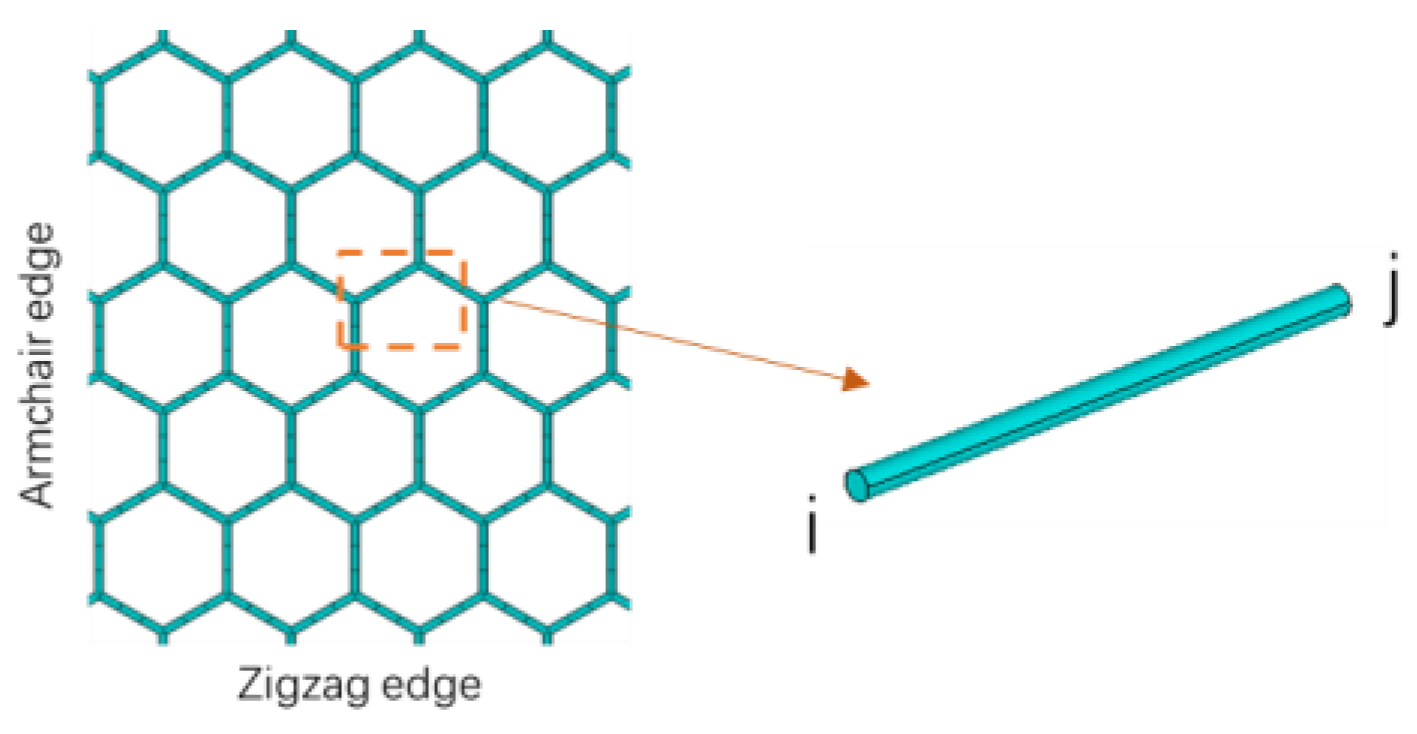
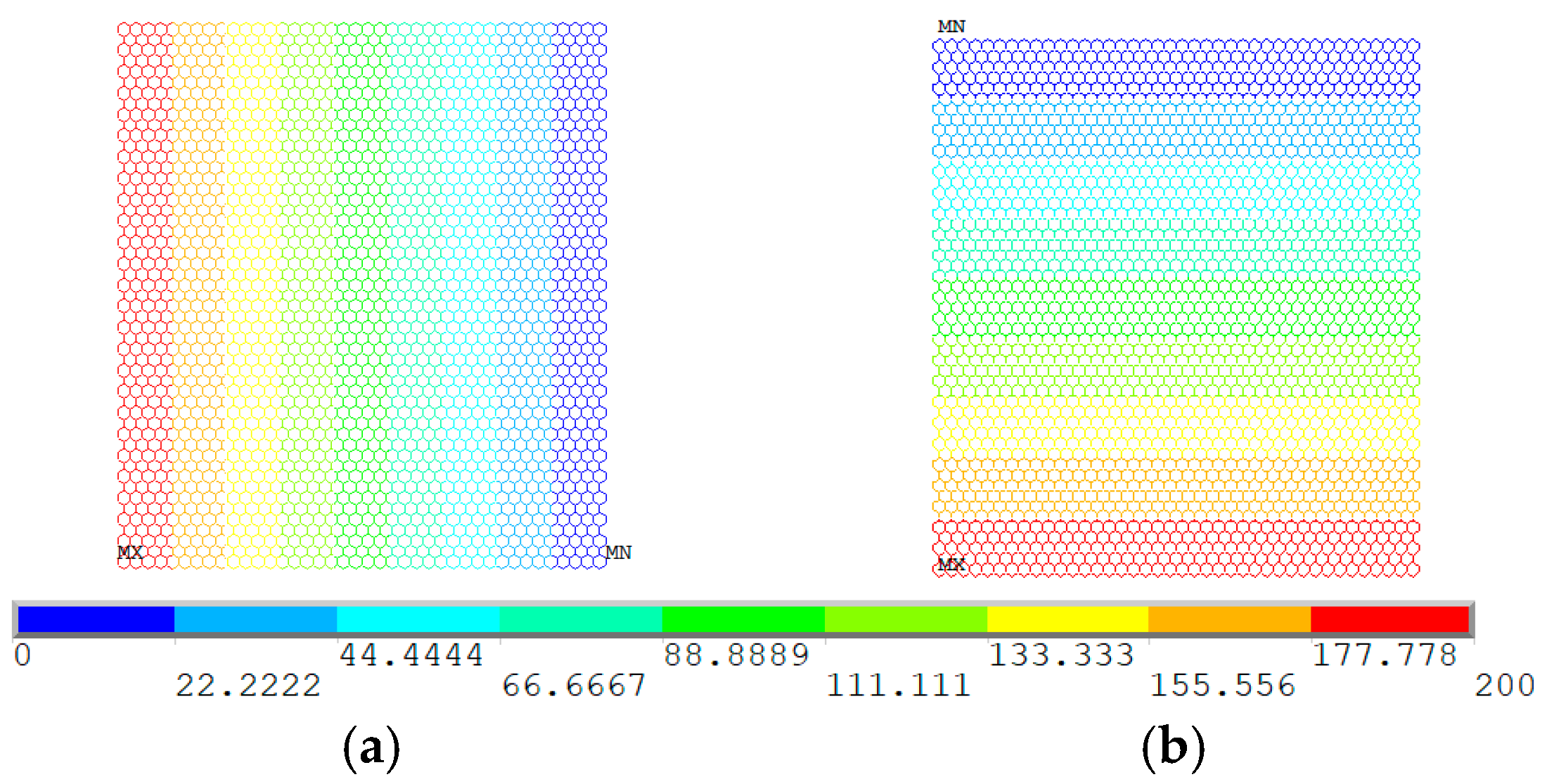
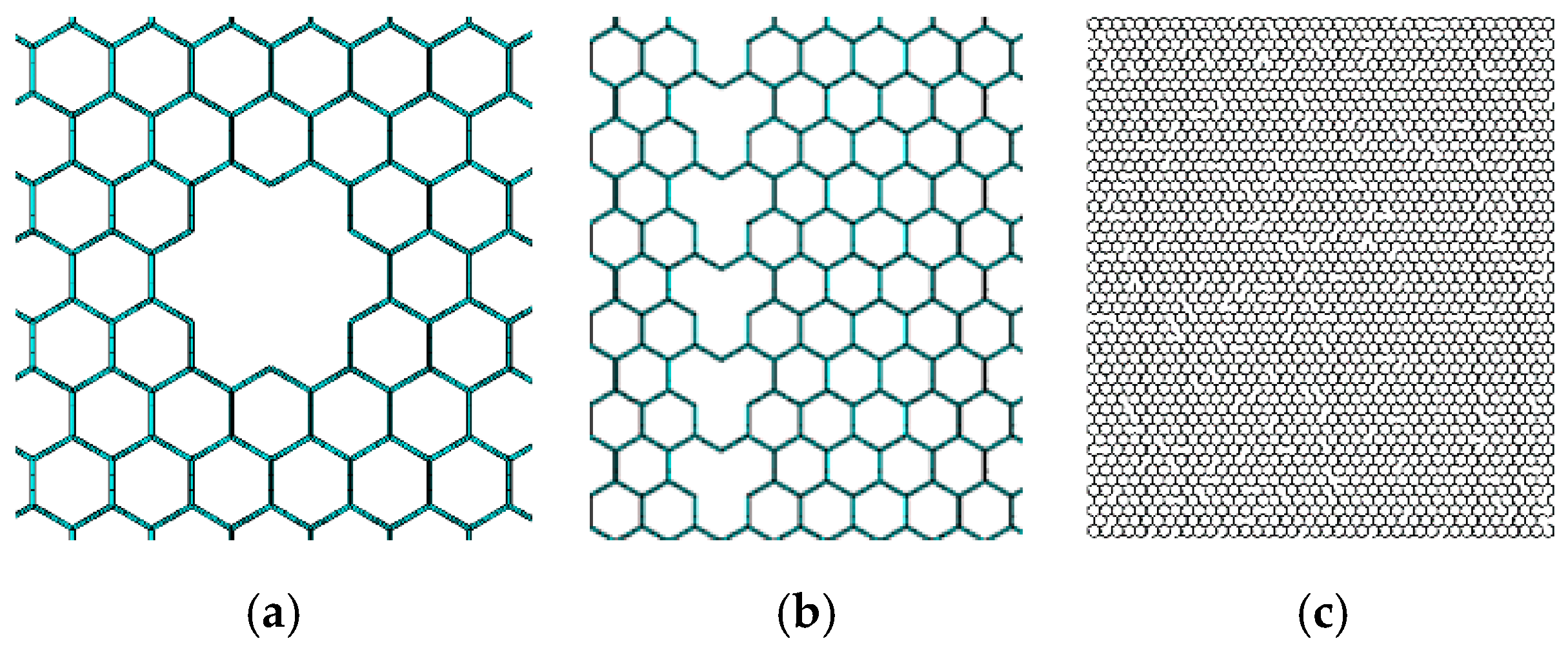

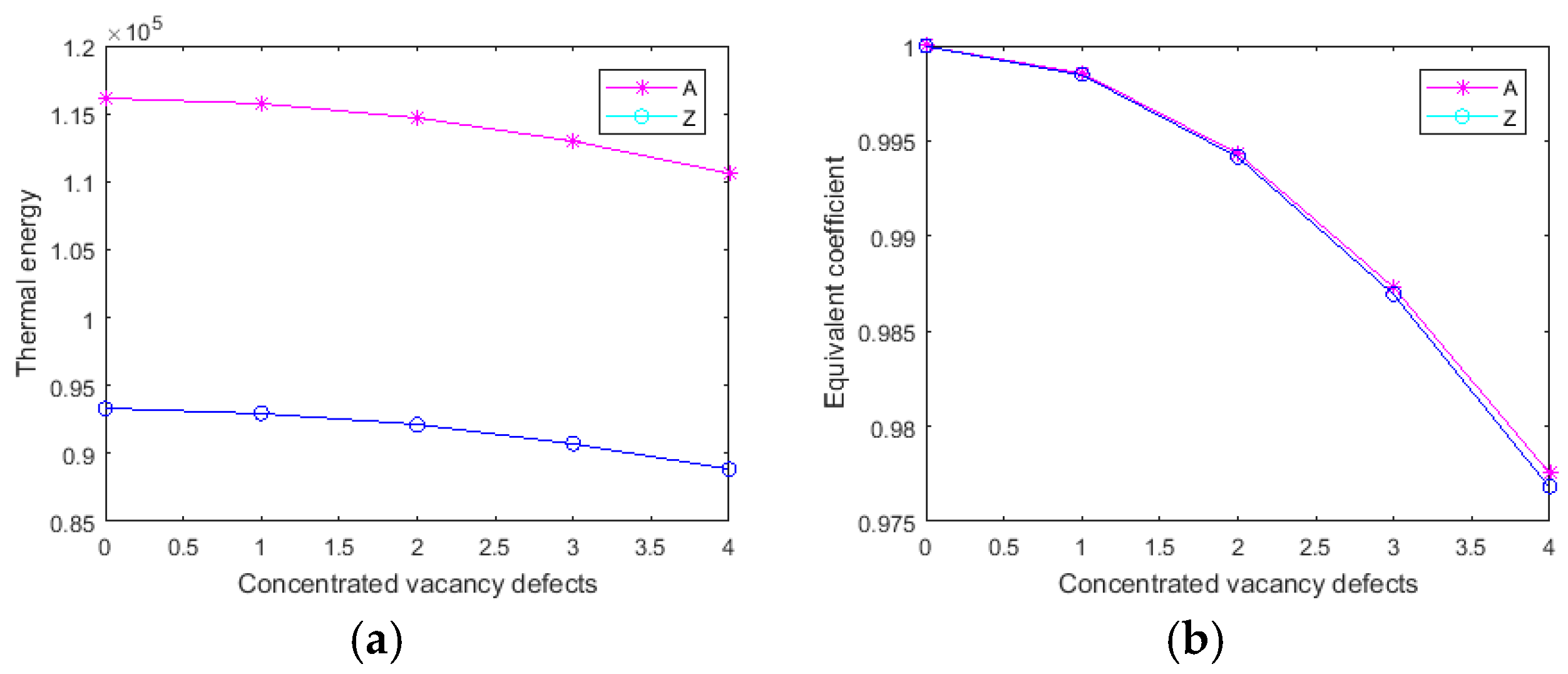



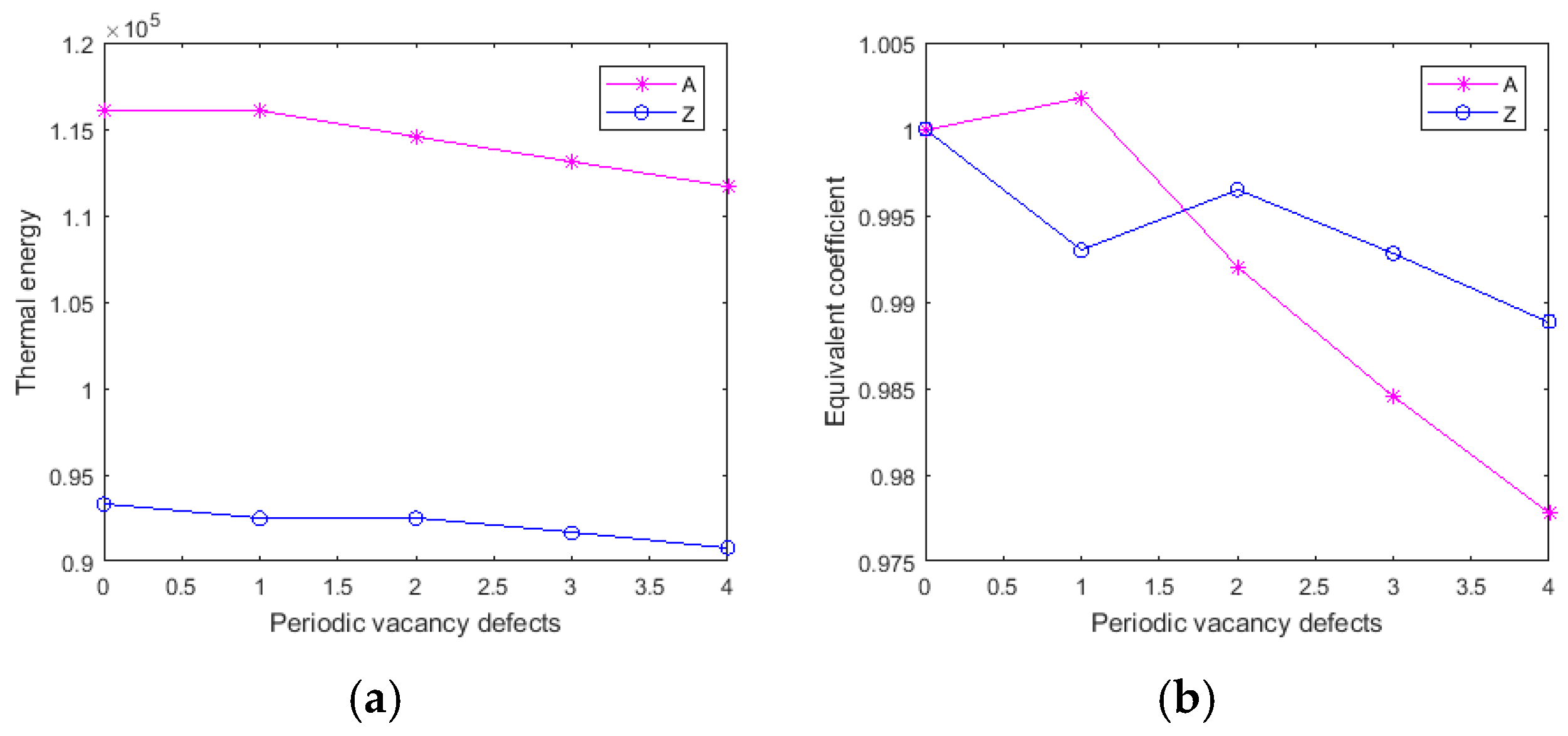


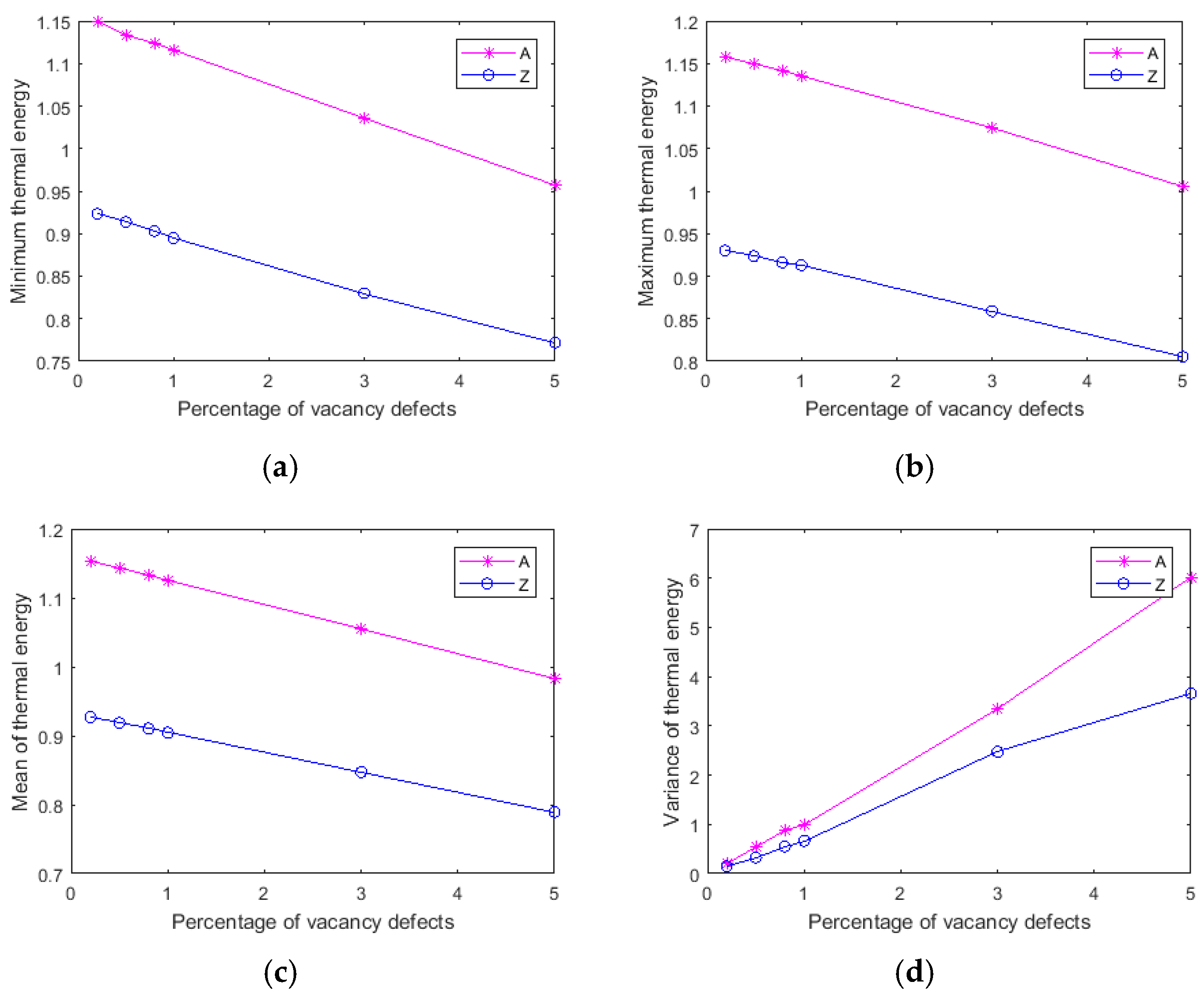
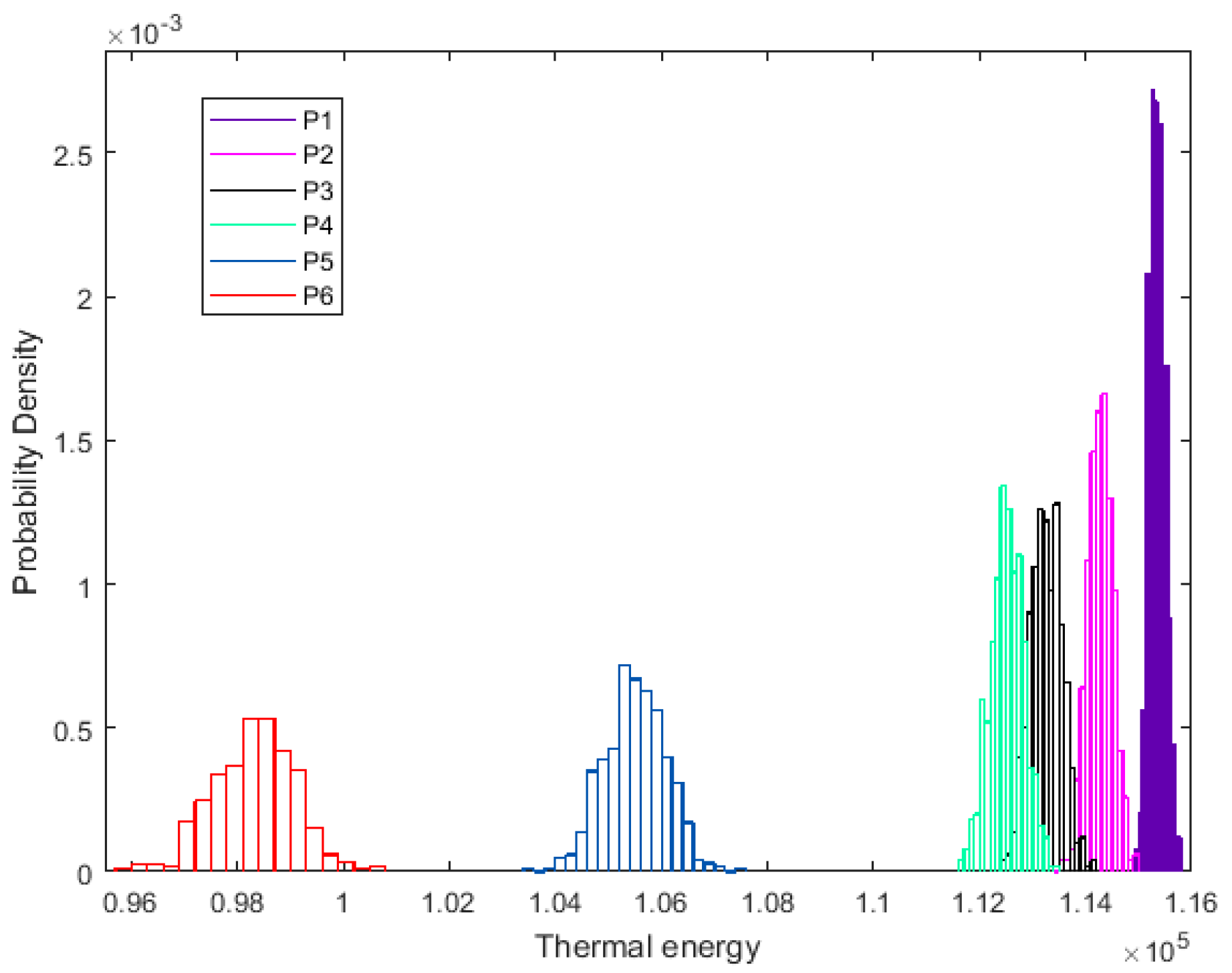

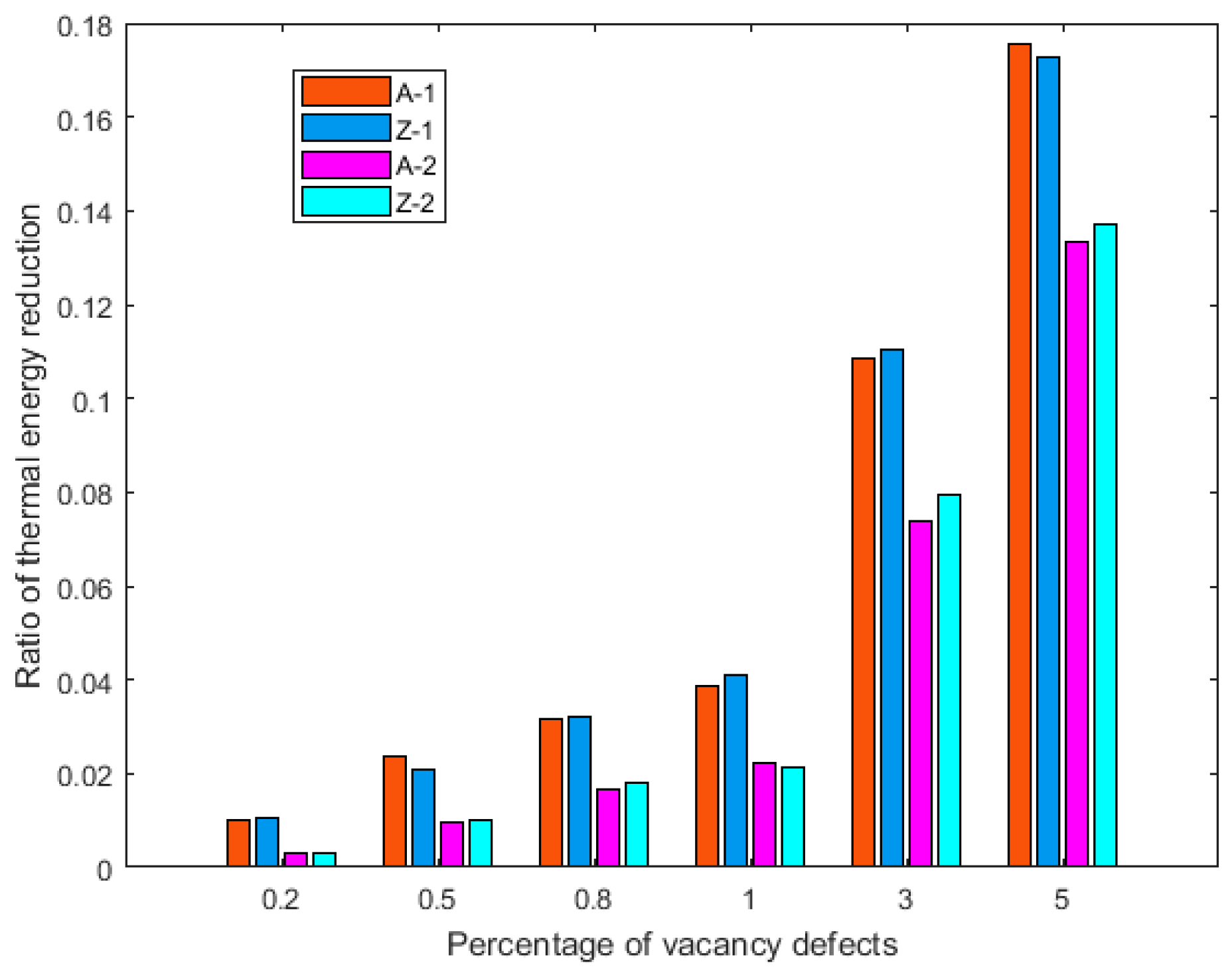
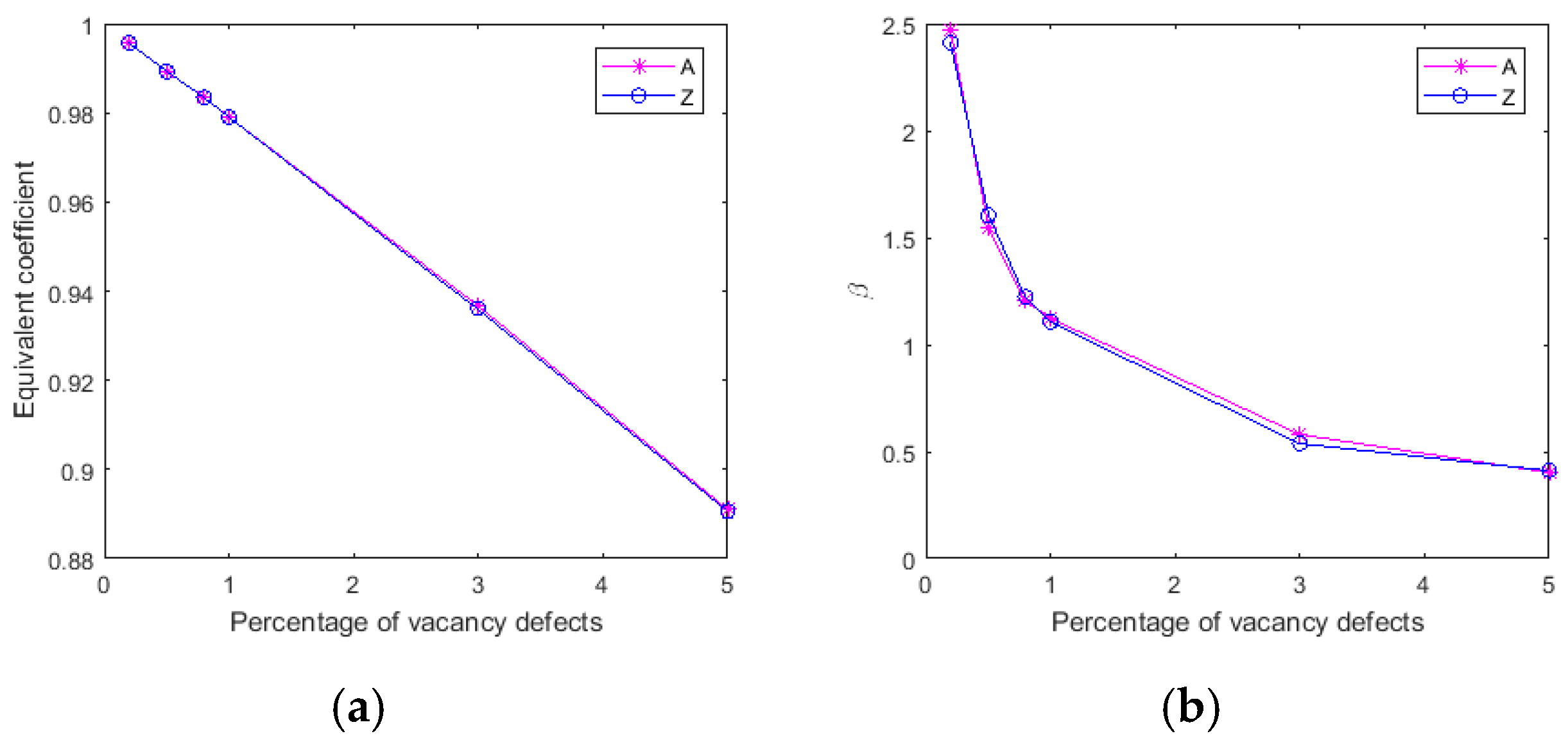
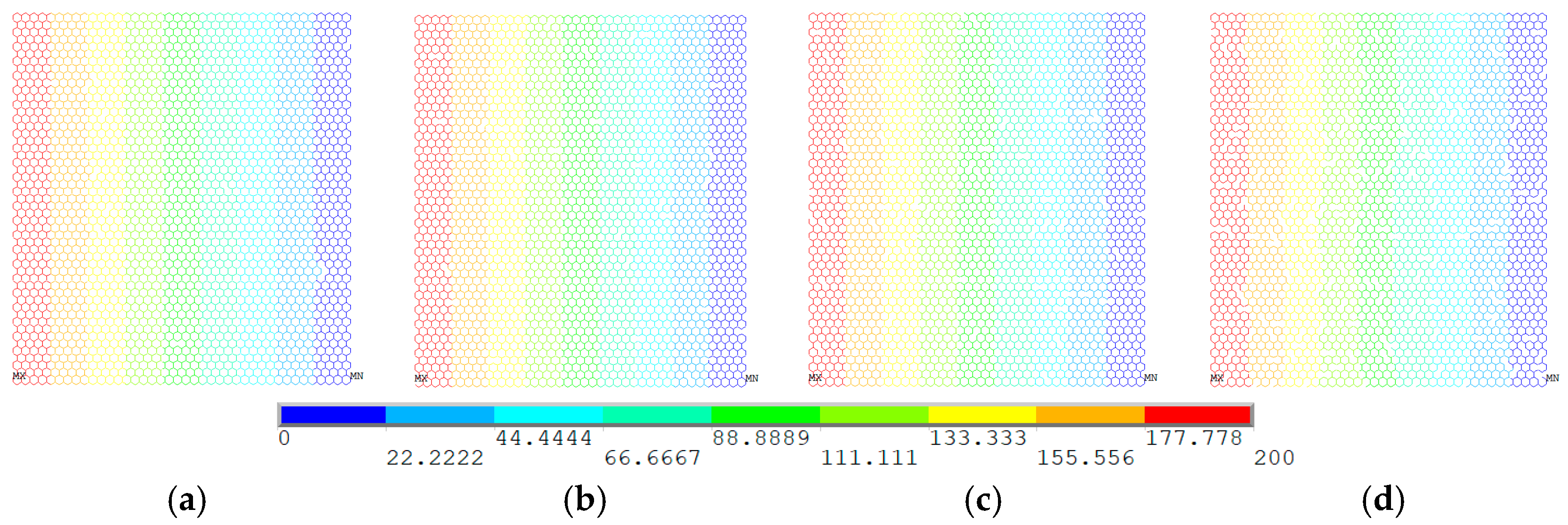
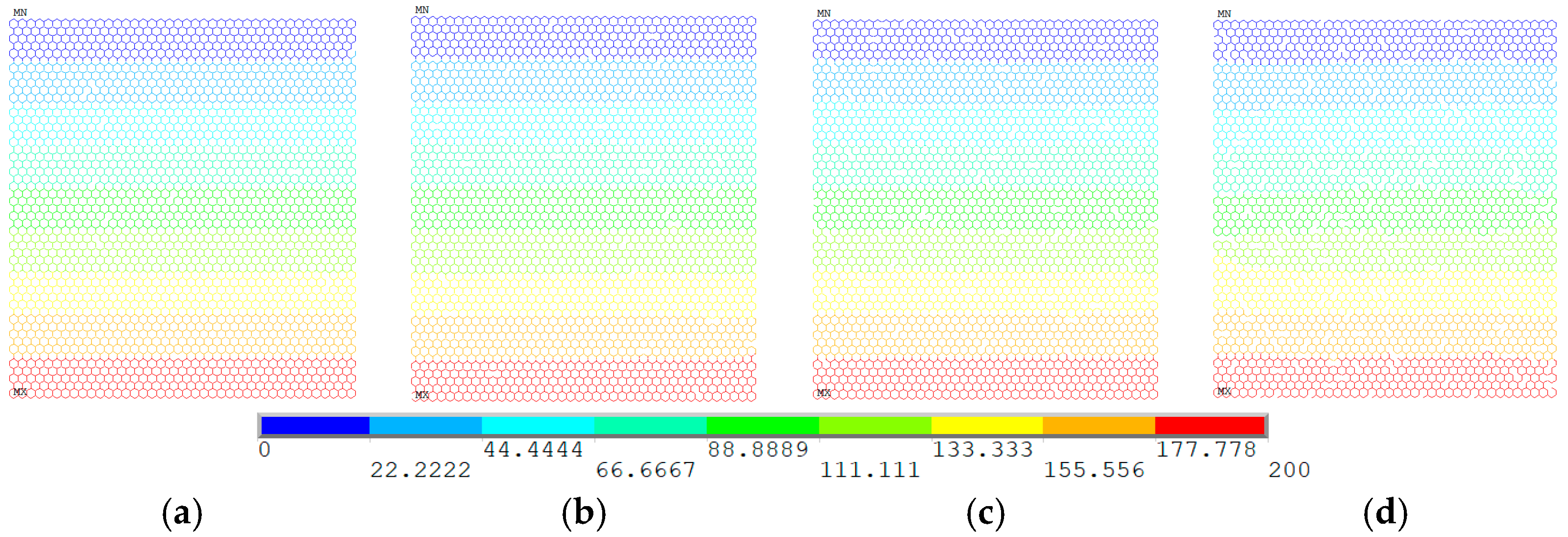
| Reference | K (W/mK) | Method |
|---|---|---|
| Balandin [8] | 2000–5000 | RO, exfoliated |
| Ghosh [10] | 1300–2800 | RO, exfoliated |
| Jauregui [14] | 1500–5000 | RO, CVD |
| Cai [12] | 2500 | RO, CVD |
| Faugeras [13] | 600 | RO, exfoliated |
| Murali [44] | 1100 | Electrical self-heating, exfoliated |
| Seol [45] | 600 | Electrical, exfoliated |
| Savin [25] | 4000 | Ballistic, width dependence |
| Nika [21] | 2000–5000 | VFF, BTE, width dependence |
| Nika [36] | 1000–5000 | RTA, size dependence |
| Evan [29] | 8000–10000 | MD, square graphene sheet |
| Lindsay [31] | 1400–2400 | BTE, length dependence |
| Type | Per (%) | Minimum | Maximum | Mean | Variance |
|---|---|---|---|---|---|
| A | 0.2 | 1.1494 | 1.1577 | 1.1535 | 0.2181 |
| 0.5 | 1.1335 | 1.1496 | 1.1428 | 0.5465 | |
| 0.8 | 1.1243 | 1.1419 | 1.1326 | 0.8798 | |
| 1 | 1.1163 | 1.1349 | 1.1252 | 1.0048 | |
| 3 | 1.0349 | 1.0752 | 1.0550 | 3.3332 | |
| 5 | 0.9571 | 1.0063 | 0.9831 | 6.0168 | |
| Z | 0.2 | 0.9232 | 0.9301 | 0.9271 | 0.1480 |
| 0.5 | 0.9135 | 0.9234 | 0.9184 | 0.3278 | |
| 0.8 | 0.9032 | 0.9161 | 0.9102 | 0.5540 | |
| 1 | 0.8948 | 0.9130 | 0.9043 | 0.6667 | |
| 3 | 0.8300 | 0.8589 | 0.8472 | 2.4754 | |
| 5 | 0.7718 | 0.8050 | 0.7894 | 3.6630 |
© 2019 by the authors. Licensee MDPI, Basel, Switzerland. This article is an open access article distributed under the terms and conditions of the Creative Commons Attribution (CC BY) license (http://creativecommons.org/licenses/by/4.0/).
Share and Cite
Sun, L.; Chu, L.; Shi, J.; Souza de Cursi, E. The Impacts of Random Distributed Vacancy Defects in Steady-State Thermal Conduction of Graphene. Appl. Sci. 2019, 9, 2363. https://doi.org/10.3390/app9112363
Sun L, Chu L, Shi J, Souza de Cursi E. The Impacts of Random Distributed Vacancy Defects in Steady-State Thermal Conduction of Graphene. Applied Sciences. 2019; 9(11):2363. https://doi.org/10.3390/app9112363
Chicago/Turabian StyleSun, Linlin, Liu Chu, Jiajia Shi, and Eduardo Souza de Cursi. 2019. "The Impacts of Random Distributed Vacancy Defects in Steady-State Thermal Conduction of Graphene" Applied Sciences 9, no. 11: 2363. https://doi.org/10.3390/app9112363
APA StyleSun, L., Chu, L., Shi, J., & Souza de Cursi, E. (2019). The Impacts of Random Distributed Vacancy Defects in Steady-State Thermal Conduction of Graphene. Applied Sciences, 9(11), 2363. https://doi.org/10.3390/app9112363





